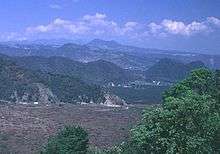Naolinco volcanic field
Naolinco volcanic field is a volcanic field in Veracruz, Mexico.[2] It lies in the region of the cities of Jalapa and Naolinco,[3] and the town of Naolinco lies in the field.[4]

Geologic context
The Trans-Mexican Volcanic Belt is best known for calc-alkaline volcanoes such as Pico de Orizaba and Popocatepetl stratovolcanoes as well as calderas and pyroclastic cones; however it also features scattered alkali basalt volcanism. It lies at an angle to the Middle America Trench unlike the more typical volcanic arcs of Central America;[5] some theories consider the belt to be independent from the trench.[6] In its eastern region lies the Cofre de Perote and a group of volcanoes including the Naolinco Volcanic Field.[7]
Sometimes it and some neighbouring monogenetic volcanoes such as those at Cofre de Perote are included into a "Xalapa volcanic field", which would have about 50 volcanic centres.[8] Despite their location, they are most likely unrelated to Cofre de Perote itself.[7]
The field
The Naolinco Volcanic Field lies in the Sierra de Chiconquiaco.[7] It includes the volcanic cones of Cerro Acatlan, which is the largest cone in the field,[1] Cerro el Hoyo, two Cerro Gordo cones, Cerro Organo and Pueblo Viejo.[9] The cone Rincon de Chapultepec has a crater 275 metres (902 ft) wide.[10] The individual centres appear to be aligned in a northeast-southwest direction.[11] Lava flows from Naolinco volcanoes have flowed south.[4] Pyroclastic material is also found in the area.[1]
Eruptive history
Potassium-argon dating of the field has yielded ages of 1.2 and 0.82 million years ago.[12] Volcanic products at Naolinco are mainly basaltic.[1]
The most recent activity at Naolinco occurred at Rincon de Chapultepec, which erupted the Coacotzintla lava flow 2,980 years before present.[8] This lava flow reached a length of 6 kilometres (3.7 mi) and a surface area of 8.1 square kilometres (3.1 sq mi); the total volume of lava is about 122,000,000 cubic metres (4.3×109 cu ft).[13] Two other lava flows were erupted by the cone, one of which is buried by scoria.[10]
Future eruptions of Naolinco, especially very voluminous ones, may endanger towns and cities in the area,[14] although most of them would affect the sparsely populated Naolinco valley unless fairly long.[2]
References
- "Naolinco Volcanic Field". Global Volcanism Program. Smithsonian Institution.
- Siebert & Carrasco-Núñez 2002, p. 202.
- Siebert & Carrasco-Núñez 2002, p. 181.
- Siebert & Carrasco-Núñez 2002, p. 184.
- Siebert & Carrasco-Núñez 2002, p. 180.
- Rodríguez et al. 2010, p. 149.
- Siebert & Carrasco-Núñez 2002, p. 183.
- Paolo Papale (29 October 2014). Volcanic Hazards, Risks and Disasters. Academic Press. p. 328. ISBN 978-0-12-396476-2.
- Siebert & Carrasco-Núñez 2002, p. 186.
- Siebert & Carrasco-Núñez 2002, p. 190.
- Rodríguez et al. 2010, p. 150.
- Orozco-Esquivel, Teresa; M. Petrone, Chiara; Ferrari, Luca; Tagami, Takahiro; Manetti, Piero (2007-01-01). "Geochemical and isotopic variability in lavas from the eastern Trans-Mexican Volcanic Belt: Slab detachment in a subduction zone with varying dip". Lithos. 93 (1–2): 156. doi:10.1016/j.lithos.2006.06.006.
- Siebert & Carrasco-Núñez 2002, p. 185.
- Siebert & Carrasco-Núñez 2002, p. 200.
Sources
- Rodríguez, S. R.; Morales-Barrera, W.; Layer, P.; González-Mercado, E. (2010-11-30). "A quaternary monogenetic volcanic field in the Xalapa region, eastern Trans-Mexican volcanic belt: Geology, distribution and morphology of the volcanic vents". Journal of Volcanology and Geothermal Research. Continental Margin Volcanism - A volume in memory of James F. Luhr. 197 (1–4): 149–166. doi:10.1016/j.jvolgeores.2009.08.003.CS1 maint: ref=harv (link)
- Siebert, Lee; Carrasco-Núñez, Gerardo (2002-06-15). "Late-Pleistocene to precolumbian behind-the-arc mafic volcanism in the eastern Mexican Volcanic Belt; implications for future hazards". Journal of Volcanology and Geothermal Research. 115 (1–2): 179–205. doi:10.1016/S0377-0273(01)00316-X.CS1 maint: ref=harv (link)